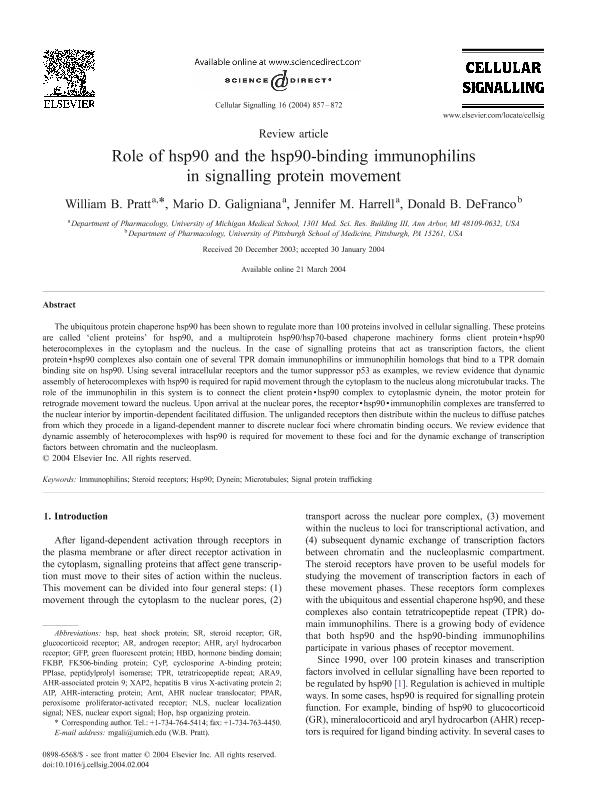Mostrar el registro sencillo del ítem
dc.contributor.author
Pratt, William B.

dc.contributor.author
Galigniana, Mario Daniel

dc.contributor.author
Harrell, Jennifer M.

dc.contributor.author
de Franco, Donald B.
dc.date.available
2017-11-25T11:13:22Z
dc.date.issued
2004
dc.identifier.citation
Pratt, William B.; Galigniana, Mario Daniel; Harrell, Jennifer M.; de Franco, Donald B.; Role of hsp90 and the hsp90-binding immunophilins in signalling protein movement; Elsevier Inc; Cellular Signalling; 16; 8; -1-2004; 857-872
dc.identifier.issn
0898-6568
dc.identifier.uri
http://hdl.handle.net/11336/29102
dc.description.abstract
The ubiquitous protein chaperone hsp90 has been shown to regulate more than 100 proteins involved in cellular signalling. These proteins are called 'client proteins' for hsp90, and a multiprotein hsp90/hsp70-based chaperone machinery forms client protein.hsp90 heterocomplexes in the cytoplasm and the nucleus. In the case of signalling proteins that act as transcription factors, the client protein.hsp90 complexes also contain one of several TPR domain immunophilins or immunophilin homologs that bind to a TPR domain binding site on hsp90. Using several intracellular receptors and the tumor suppressor p53 as examples, we review evidence that dynamic assembly of heterocomplexes with hsp90 is required for rapid movement through the cytoplasm to the nucleus along microtubular tracks. The role of the immunophilin in this system is to connect the client protein.hsp90 complex to cytoplasmic dynein, the motor protein for retrograde movement toward the nucleus. Upon arrival at the nuclear pores, the receptor.hsp90.immunophilin complexes are transferred to the nuclear interior by importin-dependent facilitated diffusion. The unliganded receptors then distribute within the nucleus to diffuse patches from which they proceed in a ligand-dependent manner to discrete nuclear foci where chromatin binding occurs. We review evidence that dynamic assembly of heterocomplexes with hsp90 is required for movement to these foci and for the dynamic exchange of transcription factors between chromatin and the nucleoplasm.
dc.format
application/pdf
dc.language.iso
eng
dc.publisher
Elsevier Inc

dc.rights
info:eu-repo/semantics/openAccess
dc.rights.uri
https://creativecommons.org/licenses/by-nc-nd/2.5/ar/
dc.subject.classification
Bioquímica y Biología Molecular

dc.subject.classification
Ciencias Biológicas

dc.subject.classification
CIENCIAS NATURALES Y EXACTAS

dc.title
Role of hsp90 and the hsp90-binding immunophilins in signalling protein movement
dc.type
info:eu-repo/semantics/article
dc.type
info:ar-repo/semantics/artículo
dc.type
info:eu-repo/semantics/publishedVersion
dc.date.updated
2017-11-16T15:12:18Z
dc.identifier.eissn
1873-3913
dc.journal.volume
16
dc.journal.number
8
dc.journal.pagination
857-872
dc.journal.pais
Países Bajos

dc.journal.ciudad
Amsterdam
dc.description.fil
Fil: Pratt, William B.. University of Michigan; Estados Unidos
dc.description.fil
Fil: Galigniana, Mario Daniel. University of Michigan; Estados Unidos. Consejo Nacional de Investigaciones Científicas y Técnicas; Argentina
dc.description.fil
Fil: Harrell, Jennifer M.. University of Michigan; Estados Unidos
dc.description.fil
Fil: de Franco, Donald B.. University of Pittsburgh; Estados Unidos
dc.journal.title
Cellular Signalling

dc.relation.alternativeid
info:eu-repo/semantics/altIdentifier/url/http://www.sciencedirect.com/science/article/pii/S0898656804000257?via%3Dihub
dc.relation.alternativeid
info:eu-repo/semantics/altIdentifier/url/10.1016/j.cellsig.2004.02.004
dc.relation.alternativeid
info:eu-repo/semantics/altIdentifier/pmid/15157665
Archivos asociados
